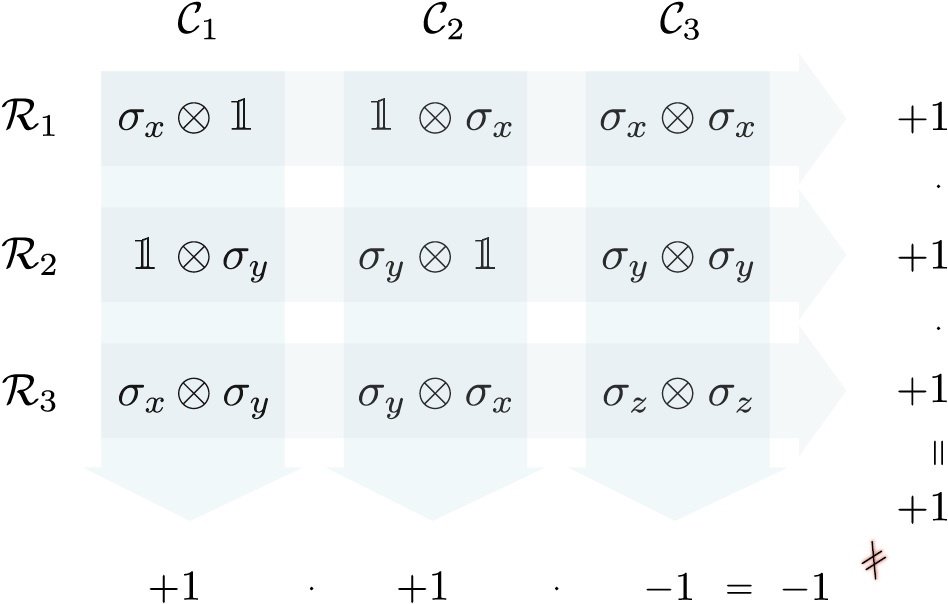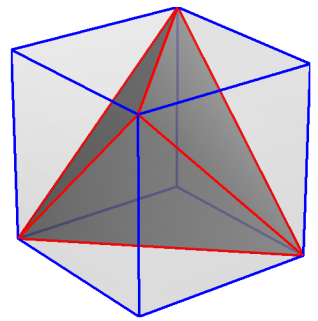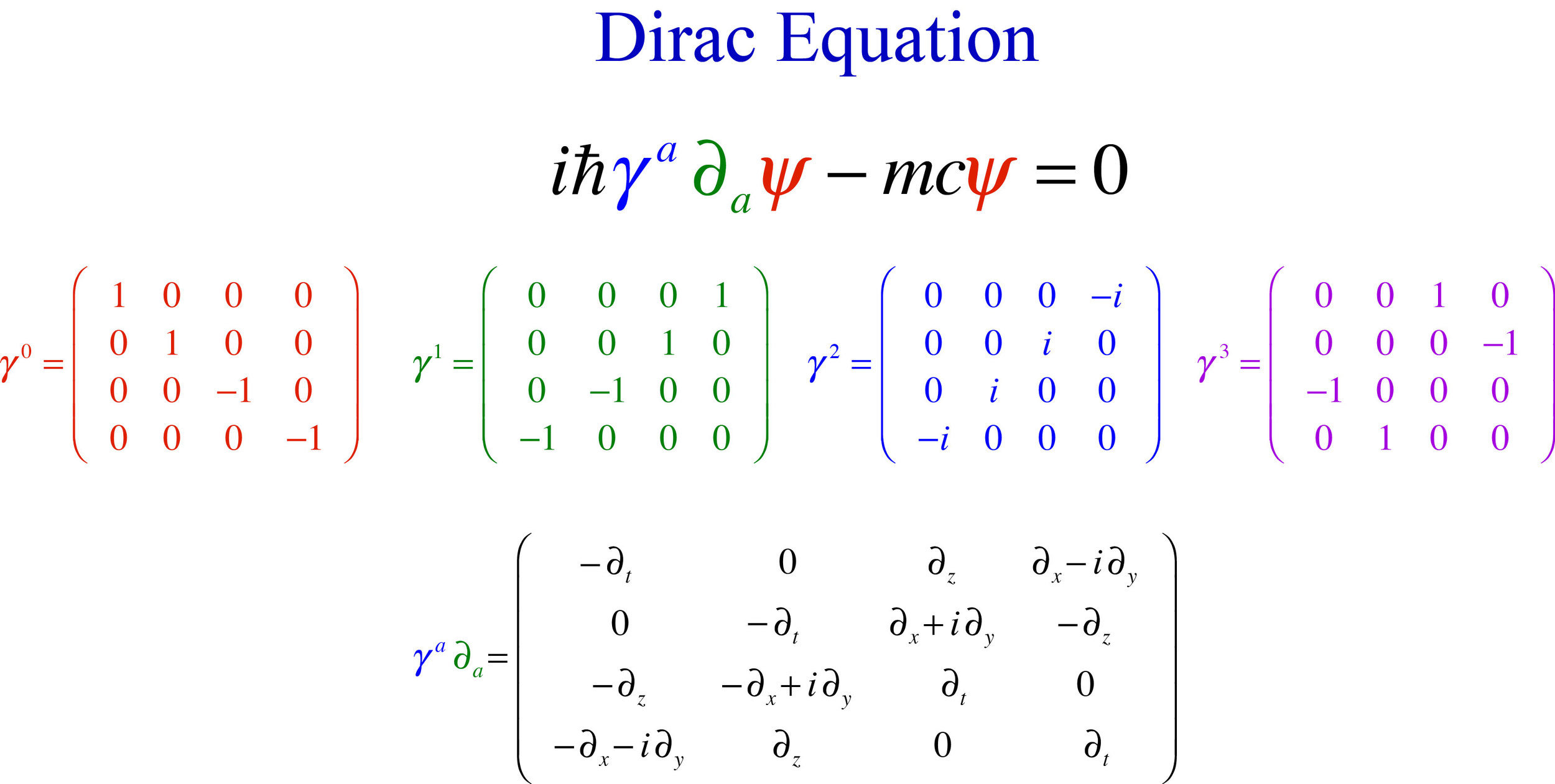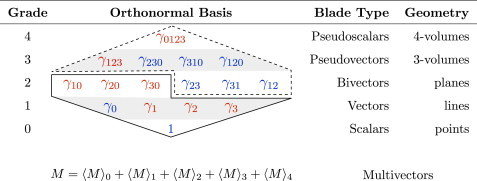Quantum Contextuality as Erasure

Justin Dressel
Lucas Burns, Lorenzo Catani
Tomas Gonda, Thomas Galley
New Directions in Function Theory:
From Complex to Hypercomplex to Non-Commutative
November 21-26, 2019, Chapman U, Orange CA
Contextuality

The seeming inability to predefine values of observed quantities.
The dependence of observed values on the specific context of how they are to be measured.
Follows from a degeneracy of operational description: a single operational description may correspond to multiple physical situations => information about any physical distinction is inaccessible operationally
Peres-Mermin Square
|
Blasiak, DOI:10.1016/j.aop.2014.10.016 |
Operational Degeneracy from Erasure
Suppose the corners of the tetrahedron at right are physically distinct states. Any operationally measurable probabilistic mixture uniquely corresponds to a point inside the tetrahedron.
The tetrahedron inscribes a cube, so projecting the tetrahedron to a lower dimension produces a square. The corners of the square still correspond to the original physically distinct states. However, now the interior points can correspond to distinct physical mixtures.
- The tetrahedron is non-contextual: every operationally distinct point inside corresponds to a unique physical mixture.
- The square is contextual: some operationally distinct points can correspond to more than one distinct physical context.
- The latter is obtained from the former by erasing information contained within the projection fibers.

Quantum Contextuality from Erasure?
This erasure model works for finite dimensional probabilistic models.
Can we construct a truly quantum probabilistic space (like the qubit below) in a similar manner from a larger space such that the contextuality in the quantum setting arises explicitly from information erasure?


Spacetime Algebra


Idea : Express known quantum physics (like Dirac electron spin) using algebra, then the erasure that causes contextuality manifests as an algebraic quotient
The physically relevant algebra is the Clifford algebra of spacetime, and contains all relativistic physics (e.g., EM, Dirac theory).
Physical Assumption : Minkowski Metric
-
Events can be locally described by a Minkowski pseudo-metric space (+,-,-,-)
- Local velocities (tangent vectors of curves that connect events) must be 4-vectors that obey this metric, according to observed Lorentz symmetries
- Connecting locally flat tangent spaces constructs an event-history manifold
- Local velocities (tangent vectors of curves that connect events) must be 4-vectors that obey this metric, according to observed Lorentz symmetries
-
Idea : Construct associative algebra that encodes the metric as a vector contraction
- Yields: (orthogonal) Clifford algebra \(\text{Cl}_{1,3}(\mathbb{R})\) ("Spacetime algebra")
as full geometric tangent space of the event-history manifold
- Nested Subalgebras: \(\text{Cl}_{1,3}(\mathbb{R}) \supset \text{Cl}_{3,0}(\mathbb{R}) \supset \text{Cl}_{0,2}(\mathbb{R}) \supset \text{Cl}_{0,1}(\mathbb{R}) \supset \mathbb{R} \)
Bi-Quaternions \(\text{Cl}_{3,0}(\mathbb{R}) \sim \mathbb{C}\otimes\mathbb{H} \) (3D space relative to reference frame)
Quaternions \(\text{Cl}_{0,2}(\mathbb{R}) \sim \mathbb{H}\) (Rotation planes in 3D space)
Complex numbers \(\text{Cl}_{0,1}(\mathbb{R}) \sim \mathbb{C}\) (Single rotation plane)
Real numbers \(\mathbb{R}\) (Measurable quantity)
- Nested Subalgebras: \(\text{Cl}_{1,3}(\mathbb{R}) \supset \text{Cl}_{3,0}(\mathbb{R}) \supset \text{Cl}_{0,2}(\mathbb{R}) \supset \text{Cl}_{0,1}(\mathbb{R}) \supset \mathbb{R} \)
- Yields: (orthogonal) Clifford algebra \(\text{Cl}_{1,3}(\mathbb{R})\) ("Spacetime algebra")
Constructing Spacetime Algebra
Minkowski Space \(\mathcal{M}_{1,3}(\mathbb{R})\) :
Minkowski metric
(symmetric bilinear form)
Algebraic Axioms: \(a,b,c\in\mathcal{M}_{1,3}(\mathbb{R})\)
- Associativity
\(a(bc) = (ab)c\)
- Left Distributivity
\(a(b+c) = ab + ac\)
- Right Distributivity
\((b+c)a = ba + ca\)
- Contraction
\(a^2 = aa = \eta(a,\,a)\)
Axioms constructively define Clifford algebra \( \text{Cl}_{1,3}(\mathbb{R}) \)
Symmetric part of product encodes metric:
Anti-symmetric part is Grassman wedge product:
(others zero)
Graded Clifford Basis
- Basis properties:
Grade
0
1
2
3
4
Bivector Planes (of rotation):
3 hyperbolic | 3 elliptic
Vector Lines (of translation):
1 timelike | 3 spacelike
Scalar Points
Pseudovector Volumes:
1 spacelike | 3 timelike
Pseudoscalar 4-Volumes
Multivector: \( M = \langle M \rangle_0 + \langle M \rangle_1 + \langle M \rangle_2 + \langle M \rangle_3 + \langle M \rangle_4 \)
- Reciprocal basis:
Notational Simplifications
0
1
2
3
(Spacetime-aware "imaginary unit" is the unit pseudoscalar: \(I^2 = -1\))
(commutes with even grade, anti-commutes with odd grade)
4
Relative 3D space embedded as even-graded subspace: \( \text{Cl}_{3,0}(\mathbb{R}) \)
(Observed spatial directions in reference frame)
(Space axis dragged along temporal worldline)
Note duality transformation of left multiplication by \(-I\) : Hodge star operation
Multivector: \( M = [\alpha + (v_0 + \vec{v})\gamma_0 + \vec{A}] + I[\vec{B} + (w_0 + \vec{w})\gamma_0 + \beta] \)
Quaternions embedded as next even-graded subspace: \( \text{Cl}_{0,2}(\mathbb{R}) \)
Complex numbers embedded as next even-graded subspace: \( \text{Cl}_{0,1}(\mathbb{R}) \)
Connection to Relativistic Formalisms
Proper Form of Multivector:
\( M = \alpha + v + \mathbf{F} + Iw + I\beta = (\alpha + I\beta) + (v + Iw) + \mathbf{F} \)
Relative Frame Form of Multivector:
\( M = \alpha + (v_0 + \vec{v})\gamma_0 + (\vec{A} + I\vec{B}) + I(w_0 + \vec{w})\gamma_0 + I\beta \)
Tensor Components:
complex scalar
complex vector
bivector
scalar
polar paravector
polar vector
axial vector
axial paravector
pseudoscalar
4-vector
scalar
bivector
pseudovector
pseudoscalar
4-vector components, or a scalar and a relative 3-vector
rank-2 antisymmetric tensor components, or a pair of 3-vectors (one polar, one axial)
Fields and Derivatives
Multivector field: (in tangent algebra at point \(x\) of spacetime manifold)
\( M(x) = \alpha(x) + v(x) + \mathbf{F}(x) + Iw(x) + I\beta(x) \)
Vector derivative (Dirac operator):
\( \displaystyle \vec{\nabla} \equiv \sum_k \vec{\sigma}^k \frac{\partial}{\partial x^k} \) ; \( \vec{\nabla}\vec{v} = \vec{\nabla}\cdot\vec{v} + \vec{\nabla} \wedge \vec{v} = \vec{\nabla}\cdot\vec{v} + (\vec{\nabla}\times \vec{v})I \) (3-gradient, contains divergence and curl)
\(\nabla^2 = \nabla\gamma_0^2\nabla = (\partial_{ct} - \vec{\nabla})(\partial_{ct} + \vec{\nabla}) = \partial^2_{ct} - \vec{\nabla}\cdot\vec{\nabla} = \Box \) (d'Alembertian)
Electromagnetism: Maxwell's Equation
electric charge
density and current
This is Maxwell's Equation
Electromagnetic field bivector:
Same form as complex (Riemann-Silberstein) 3-vector
Electromagnetic source complex vector:
magnetic charge
density and current
Contains all of the usual 3D Maxwell's Equations, permitting both electric and magnetic charges
JD, et al. Physics Reports 589 1-71 (2015)
Quantum Particles in Spacetime

To move to quantum mechanics, we must understand the basic quantum objects: the spinors that obey the Dirac equation, and their associated simplifications, the Pauli spinors and Schrodinger wavefunctions
Idempotents, Ideals,
and Quantum Mechanics
- Hilbert space "kets" and "Dirac spinors" in Quantum Mechanics correspond exactly to elements of a left ideal in the spacetime algebra \(\text{Cl}_{1,3}(\mathbb{R})\)
- Hilbert space "bras" and "Dirac adjoint spinors" correspond to associated right ideals
- Hilbert space "operators" correspond to central ideals
- Ideals (right, left, and central) are generated by idempotents in the algebra
- There are three nontrivial classes of idempotents in \(\text{Cl}_{1,3}(\mathbb{R})\):
\( \displaystyle \epsilon_1 = \frac{1 + \gamma_0}{2} \) \( \displaystyle \epsilon_2 = \frac{1 + \vec{\sigma}_3}{2} \) \( \displaystyle \epsilon_3 = \frac{1 + \gamma_0 I }{2} \)
Choice of Lorentz Frame
Choice of Spatial Reference within a particular Lorentz Frame
For the simplest case of "nonrelativistic spin", the relevant idempotent is \(\epsilon_2\)
Hiley, Callaghan, arXiv:1011.4033
\( \displaystyle \epsilon_1 = \frac{1 + \gamma_0}{2} \) \( \epsilon_1 = \gamma_0 \, \epsilon_1 \)
Ideals and Dirac Spinors
A left ideal based on \( \epsilon_1 \) reduces the 16-dimensional algebra to an 8-component (Dirac) spinor, equivalent to 4 complex components:
The corresponding right ideal is the adjoint spinor:
Their product is the Dirac spinor inner product:
The Dirac spinor can be understood as two quaternions, each equivalent to a Pauli spinor:
\( \Psi \epsilon_1 = [\alpha + \vec{A} + I(\beta + \vec{B})] \epsilon_1 \leftrightarrow \Psi \)
\( \epsilon_1 \tilde{\Psi} = \epsilon_1 [\alpha - \vec{A} + I(\beta - \vec{B})] \leftrightarrow \bar{\Psi} \)
\( \epsilon_1 \tilde{\Psi}\Psi \epsilon_1 = [|\alpha|^2 - |\vec{A}|^2 - |\beta|^2 + |\vec{B}|^2]\epsilon_1 \leftrightarrow \bar{\Psi} \Psi \)
\( \Psi \epsilon_1 = [(\alpha + I\vec{B}) + I(\beta - I\vec{A})] \epsilon_1 \\ \qquad = [\psi + I\phi]\epsilon_1 \leftrightarrow \begin{pmatrix}|\psi \rangle \\ |\phi \rangle \end{pmatrix} \)
\( \epsilon_1 \tilde{\Psi}\Psi \epsilon_1 \leftrightarrow \langle \psi | \psi \rangle - \langle \phi | \phi \rangle \)
\( \displaystyle \epsilon_2 = \frac{1 + \vec{\sigma}_3}{2} \) \( \epsilon_2 = \vec{\sigma}_3 \, \epsilon_2 \) \( \displaystyle \epsilon_1 = \frac{(1-\gamma_3)\epsilon_2(1 + \gamma_3)}{2} = \frac{(1 + \gamma_0)\epsilon_2(1 + \gamma_0)}{2}\)
Ideals and Pauli Spinors
An equivalent left ideal based on \( \epsilon_2 \) directly isolates the relevant Pauli spinors:
\( \Psi \epsilon_2 = [(\alpha + I\vec{B}) + (v_0 + I\vec{w})\gamma_0] \epsilon_2 = [\psi + \phi\gamma_0]\epsilon_2 \)
\( \psi\epsilon_2 = [\alpha + I\vec{B}]\epsilon_2 = [(\alpha + B_3 I) + (B_2 - B_1 I) I\vec{\sigma}_2] \epsilon_2 \)
\(\epsilon_2 \leftrightarrow |0\rangle \)
\( I\vec{\sigma}_2\epsilon_2 \leftrightarrow i\hat{\sigma}_2|0\rangle = |1\rangle \)
\( \psi\epsilon_2 = (\alpha + I\vec{B})\epsilon_2 \leftrightarrow (\alpha + B_3 I)|0\rangle + (B_2 - B_1 I)|1\rangle = |\psi\rangle \)
For nonrelativistic cases, the first Pauli spinor is sufficient, and produces a spin qubit:
Left ideal \(\leftrightarrow\) Pauli Spinors/Kets
Central ideal \(\leftrightarrow\) Operators
\(\epsilon_2 \leftrightarrow |0\rangle\langle 0 | \)
\( (I\vec{\sigma}_2)\epsilon_2(-I\vec{\sigma}_2) \leftrightarrow |1\rangle\langle 1 | \)
\( \psi\epsilon_2\tilde{\psi} \leftrightarrow |\psi \rangle\langle \psi | \)
Reduction as Erasure
- The progression from the full algebra \(\text{Cl}_{1,3}(\mathbb{R})\) to a qubit can be understood as a succession of projections that erase information:
- Selecting an ideal isolates a Dirac spinor:
\( M \in \text{Cl}_{1,3}(\mathbb{R}) \mapsto M\epsilon_2 = \Psi\epsilon_2 \), \(\Psi \in \text{Cl}_{3,0} \sim \mathbb{C}\otimes\mathbb{H} \) - Eliminating boosts isolates a Pauli spinor:
\(\Psi\epsilon_2 \mapsto \langle\Psi\epsilon_2\rangle_{\text{even}} = \psi\,\epsilon_2 \), \(\psi \in \text{Cl}_{0,2} \sim \mathbb{H}\) - Keeping only one spatial axis isolates a Schrodinger wavefunction:
\(\psi\,\epsilon_2 \mapsto \epsilon_2\psi\epsilon_2 = \psi_z\,\epsilon_2 \), \(\psi_z \in \text{Cl}_{0,1} \sim \mathbb{C} \)
- Selecting an ideal isolates a Dirac spinor:
- This nesting of algebras exactly mirrors the even-graded subalgebras:
\( \text{Cl}_{1,3}(\mathbb{R}) \supset \text{Cl}_{3,0}(\mathbb{R}) \supset \text{Cl}_{0,2}(\mathbb{R}) \supset \text{Cl}_{0,1}(\mathbb{R}) \)
Multivector \(\supset\) Dirac spinor \(\supset\) Pauli spinor \(\supset\) Schrodinger Wavefunction
- In this precise sense, one must erase information from a larger geometric space to obtain the relevant quantum space
Multi-particle Erasure
- This erasure becomes even more striking with two particles :
- To obtain a "tensor product" within the algebra that behaves correctly, one has to duplicate the entire spacetime: \( \text{Cl}(\mathcal{M}_{1,3}\oplus\mathcal{M}_{1,3}) \)
- This creates a dimensionality of \(2^{4+4} = 256\), which is far too large (should be 8)
- The correct quantum space of two nonrelativistic spins is obtained after not just projecting to separate ideals on each spacetime, but by projecting onto an ideal of a correlated idempotent that glues together reference orientations of the independent spacetimes
\( \displaystyle \epsilon_{22} = \frac{1 + \vec{\sigma}^{(1)}_3\vec{\sigma}^{(2)}_3}{2} \leftrightarrow |0\rangle|0\rangle \), \( \displaystyle \exp(-I \sum_{ij}h_{ij}\vec{\sigma}^{(1)}_i\vec{\sigma}^{(2)}_j)\,\epsilon_{22} \leftrightarrow |\Psi\rangle \)
- This gluing procedure permits entanglement between the particles: the most well-known consequence of contextuality!
\( \displaystyle \frac{1 - \vec{\sigma}^{(1)}_1\vec{\sigma}^{(2)}_1}{\sqrt{2}}\frac{1 - \vec{\sigma}^{(1)}_3\vec{\sigma}^{(2)}_3}{2} \leftrightarrow \frac{|1\rangle|0\rangle - |0\rangle|1\rangle}{\sqrt{2}} \)
Notably an entangled state can be understood directly as a product of correlated idempotents that identify spin axes of both particles
Conclusions
- Spacetime Clifford algebra is the natural language of relativistic physics
- Multiparticle quantum mechanics is constructed algebraically as a correlated ideal within redundant copies of spacetime
- There is a close correspondence between the erasure of information inherent to the procedure of forming ideals and the operational degeneracy that appears in the form of quantum contextuality

Thank you!
Quantum Contextuality as Erasure
By Justin Dressel
Quantum Contextuality as Erasure
New Directions in Function Theory: From Complex to Hypercomplex to Non-commutative, November 21-26 2019, Chapman University, ORANGE, CA Abstract: We formulate multiparticle quantum mechanics as an algebraic quotient space constructed from redundant copies of spacetime. We demonstrate that the needed equivalence relation erases geometric distinctions, leading to entanglement correlations and other context-dependent measurement effects. This quotient construction has close connections to resource theories derived from symmetry groups, which we also review.
- 1,261



